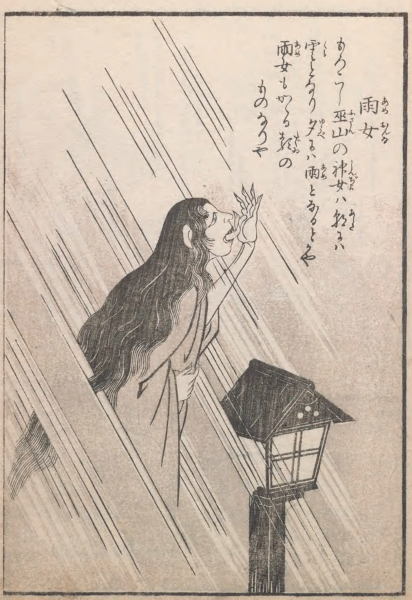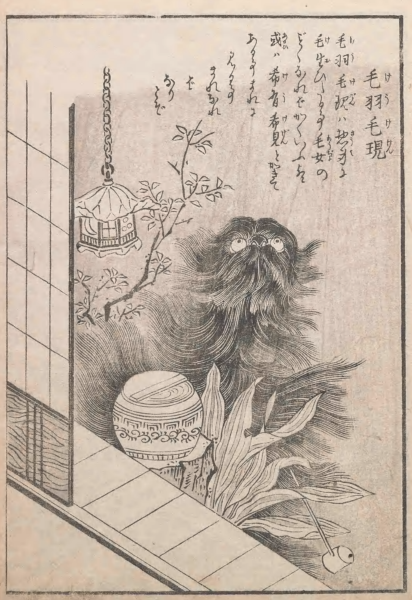After the Konjaku Zoku hyakki, the Sequel to the Hundred Ghosts, had been published in I/1779, Sekien wasn’t given too much of a break. The continuing success made his publishers again ask him for more. And so he started working on the Konjaku – Hyakki shūi 今昔百鬼拾遺, something like ‘Gleanings of a Hundred Ghosts,’ that was published in I/1781. It is again a publication in 3 volumes hanshibon, with as mottos Clouds, Dew, and Rain. It has two prefaces and apparently also a postface. But let’s first give the collation:

Konjaku – Hyakki shūi 今昔百鬼拾遺
3 vols hanshibon Vol 1 Kumo 雲 (Clouds) 12 sh: 4 pp pref to the Hyakki shūi 百鬼拾遺 signed Genshū Shōbukan 元洲勝武幹, s: Genshū, Shōbukan no in 印: 元洲, 勝武幹之印, dated Anei jū kanoto mi no haru 安永十辛巳春 (Anei 10 year of the Snake, Spring, I/1781); 2 pp pref signed Sekien jijo 石燕自序 (Sekien’s own preface), dated Anei kyū no toshi rōgetsu 安永九のとし蝋月 [sic, for 臘月] (Anei 9 twelfth month, XII/1780); 1 p contents for Hyakki yagyō shūi 百鬼夜行拾遺; 2 pp frontispiece: the mirage of a clam, shinkirō 蜃気楼; 15 pp ills. Vol 2 Tsuyu 露 (Dew) 10 sh: 1 p contents; 19 pp ills. Vol 3 Ame 雨 (Rain) 9 sh: 1 p contents; 14 pp ills; 2 pp ill of Daikoku celebrating the New Year; 1 p colophon: Anei jū kanoto ushi no haru 安永十辛丑春 (Anei 10 year of the Ox, I/1781)/ Toriyama Sekien Toyofusa 鳥山石燕豊房/ assisted by his pupils Shikō 子興 (Eishōsai Chōki 栄松齋長喜)/ Enji 燕二/ block-cutter Inoue Shinshichi 井上新七/ Edo publ 江戸 Izumoji Izuminojō 出雲寺和泉掾/ Enshūya Yashichi 遠州屋弥七.
This is after a copy in the Freer Gallery of Art, Washington (ex Gerhard Pulverer , ex Henri Vever [1948:285])
The first preface, in the Joly & Inada translation, reads as follows (my annotations in square brackets):
The artist Sekiyen is a retired old man of very gentle character, he is very fond of his garden the pond of which is “9 hiro deep” (9 fathoms or brasses [仭, an ancient Chinese measure, one jin ranging from four to eight shaku, or 121 – 242 cm]) he amuses himself in that garden all the year round, in flowering spring, and in the cool shade on hot summer days (shūzui tekka nawazu [秋水荻花□]) in autumn the stream flows to the pond, laden with the floating blossoms of Hagi [萩 bush clover], in winter the whole garden is a white mass of snow, and as he thus amuses himself he does not notice the years (growing old). When anyone of similar taste pays him a visit, he offers them excellent tea and talks about painting. When he takes up his brush, he can finish more than a hundred subjects at once. He is not too old when it comes to drawing & I am astonished at the easy way in which he draws like a young man. And in consequence, he has many pupils and he has published many books well known to the public.
In the spring of the Monkey year [1776] he published Hiakki Yagio [Hyakki yagyō], the latter part of which came out during the Boar year [the Zoku hyakki, 1779], both are now out, and this year his publisher asked him for some more ghost pictures. So the old one said: If I draw this sort of subject so often, I am afraid that it may spoil my energy and that moreover, in years to come I shall be laughed at and many devils & Bakemono will be annoyed at my paintings. So his publisher said: Artists must have very superior minds (above these considerations) and if the devils are annoyed, just as if millet grains looked like drops of rain it would show the power of Art.
So earnestly did he ask the old man that Sekiyen at last took his brush again, collecting all sorts of Bakemono, to publish the third volume under the title Hiakki Shui. He asked me for a preface and I have accepted although my knowledge is so small. As the old man said: this is just for the fun of it and for the amusement of children so that you need not worry very much, & therefore I wrote this preface notwithstanding my ignorance.
Anyei 10 [1781], Genshu Tobu

The second preface, in the Joly & Inada translation, reads as follows:
Waka (Japanese poetry) has the power of expressing all feelings (even those of inanimate things). Thus paintings describe all sorts of Bakemono and devils, exaggerated by the brush as I thought of them in my mind. I am quite ashamed to have drawn such a book, but my publisher wanted it so much because it was, said he, a very good sort of book to stop children crying, and he asked me again and again for it, so that finally I have agreed to have it put upon cherry wood blocks.
Anyei 9th December [XII/1780], Sekiyen
Joly & Inada then add a postface that is apparently missing in the Freer copy, which reads as follows:
There was once a pigeon which was changed into a golden hook, and a deer that became a writing brush. Age is a treasure (old people are quite important).
Sekiyen although 72 years old is still in splendid health. He has finished from the beginning of Hiakki Yagio [Hyakki yagyō, 1776] to the latter part [the Zoku hyakki, 1779], and he has had many prefaces from many people famed in literature. At last he has succeeded in drawing another volume to add to the last edition. It is very interesting that so many devils could be made from furniture, I am surprised that he has been able to change from ordinary utensils into so many wonderful designs of Bakemono. Though he is so old, yet he has wonderful strength to draw such minute pictures and he his [is] still young in that respect. He asked me for a postface and I have written this.
Old man of Kanda (神田庵主人)
Again another nice problem, where does this postface come from, it was certainly not present in the 1805 reprint by Maekawa Rokuzaemon 前川六左衛門 and Maekawa Yahei 前川弥兵衛, at least not in the copy of this printing in the Smithsonian Institution, Washington, the only other copy I could, so far, locate on the internet and also used by Yoda and Alt.